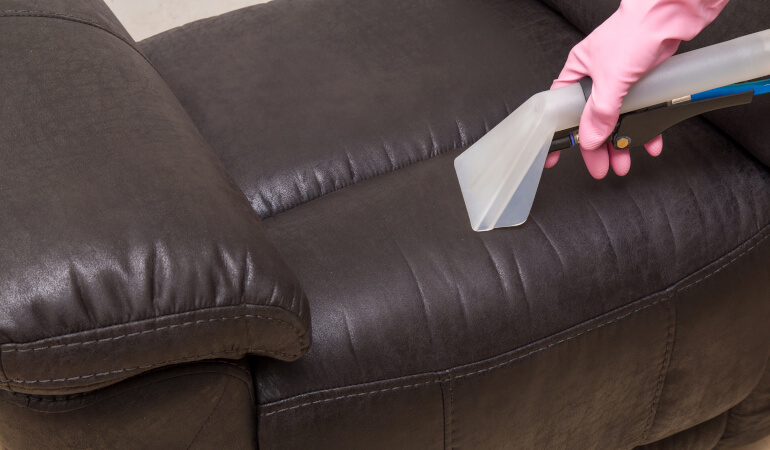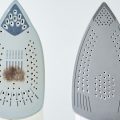
Sofas are usually the central pieces of a living room. This means they are constantly subjected to traffic, allowing dust and grime to easily accumulate over time. If neglected, the upholstered piece of furniture can suffer permanent damage and worst of all – you may need to invest in a new one. Proper and frequent cleaning can extend your couch’s lifespan, but a lot of people find that challenging when the sofa is covered with leather.
Is steam cleaning safe for leather couches? Will the use of a steam cleaner cause any damage to the furniture? Wonder no more, as you will find the answers to those and many other related questions in this guide!
Well then, let’s get right to the point.
Table of Contents
Is it safe to steam clean a leather couch?
As a general rule of thumb – water and leather don’t mix. That’s because water causes leather to stretch and is even able to rip it apart. However, this brings an interesting question: “Is steam as damaging as water if you attempt to clean your leather sofa with it?”
It’s actually not. Applying water on leather is far different from using steam. While safer, steam cleaning still needs to be done carefully, at the right temperature and at the appropriate distance. The type of leather you are attempting to clean also matters.
If you want to be on the safe side and prevent permanent damage to your leather couch when cleaning, it’s always best to schedule an expert leather cleaning session. A professional cleaner will take the time to examine your furniture, let you know what’s the best cleaning method, and then clean it perfectly for you.
Pros to leather upholstery steam cleaning
Steam cleaning leather has various benefits that other cleaning methods cannot offer. Your beloved leather furniture will benefit from all the below-mentioned perks only if the steam cleaning appliance is used correctly. You would want to adjust the heat to the lowest setting and also, as mentioned above, keep a reasonable distance from the couch itself when steam cleaning.
- Steam kills bacteria and germs – With the ability to produce higher temperatures than other leather cleaning machines, steam cleaners are perfectly able to eliminate up to 99.9% of dangerous bacteria and germs from your leather couch. It can also significantly reduce the chance of pollutant buildup, dust mite infestations and mould growth.
- Eliminates mould and mildew – If your leather sofa suffers from mould and mildew growth, you can easily remove it using a steam cleaner, as both mould and mildew can’t withstand high heat.
- Removes unpleasant smells – The hot water vapour can easily push through the leather’s layers and remove foul smells from its pores. Steam is also perfect for eliminating bad odour-producing bacteria.
- It’s environmentally friendly – Using steam for cleaning leather is entirely chemical-free. Other cleaning methods are likely to include harsh chemicals that could damage the leather and potentially produce health-related issues for more sensitive people.
- Allows to deep clean the material – Using steam to clean leather is considered highly effective because hot water vapour easily opens the pores of the leather piece. Also, steam cleaning separates and loosens the oil and dirt molecules from the material itself.
Cons of steam cleaning leather
As wonderful as steam cleaning seems for leather furniture, it does come with some disadvantages.
- Possible water damage – Steam in large amounts could make the leather appear dry, cracking, peeling and rotting. Therefore, it’s very important to know exactly how to work with a steam cleaning machine. To avoid damage, letting your leather sofa air dry by opening windows is also crucial.
- Drying of the leather – This cleaning method could dry out the leather sofa, leading to the loss of its nourishing oils. As mentioned previously, steam penetrates the pores of the leather, mixes with the oil contents and evaporates along with them. It may be effective for eradicating harmful microorganisms but it could also dry out the leather in the process. That’s why it’s imperative to condition the leather after the cleaning process.
- Possibility of mould growth – If the sofa doesn’t dry out entirely after steam cleaning, it can become the perfect environment for mould or mildew growth. To prevent that issue from happening, make sure that the room is well-ventilated.
- Leather shrinking – If your sofa is exposed to excessive amounts of water and heat during the steam cleaning, the leather’s fibres could shrink. Creases and wrinkles are telling signs.
Factors to consider prior to steam cleaning a leather sofa
Steam cleaning can be a game-changer when it comes to cleaning and maintaining your leather furniture. However, before you embark on this journey, there are crucial factors to consider to ensure your beloved leather sofa emerges from the steam cleaning process unscathed and looking its best.
Type and quality of the leather material of your sofa
If done correctly, steam cleaning can completely remove leather-damaging bacteria, which can prolong the life of your sofa. However, steam cleaning can also have a negative impact on the sofa’s durability. High steam pressure or prolonged exposure can weaken the leather fibres and cause them to lose their natural oils, leading to dryness and potential cracking.
When it comes to steam cleaning a leather sofa, it’s crucial to understand the type and quality of the leather material. The type of leather used can significantly impact how well it responds to steam cleaning and whether it’s suitable for this cleaning method. Here are some common types of leather used in sofas and their quality considerations for steam cleaning:
- Aniline leather is made from high-quality full-grain leather. It is dyed with soluble dyes that penetrate the leather, allowing the natural grain and texture to show through. The material is very soft, supple, and luxurious. However, it is highly porous and susceptible to stains and fading. Steam cleaning should be approached with caution, as excess moisture can cause water stains and damage the delicate surface.
- Semi-aniline leather is similar to aniline but has a light protective coating or pigment applied to it. It offers better stain resistance and colour consistency compared to pure aniline leather. While steam cleaning can be used on semi-aniline leather, care should still be taken to prevent over-saturation and water damage.
- Faux leather is made from synthetic material, designed to mimic the appearance of leather. Faux leather is typically less sensitive to moisture than real leather and can often withstand steam cleaning better. However, it’s essential to follow the manufacturer’s recommendations for cleaning faux leather, as some types may have specific care instructions.
- Bonded leather is made by binding together shredded or ground-up pieces of genuine leather with a polyurethane or vinyl binder. The resulting material is then embossed and finished to mimic the look and feel of genuine leather. Bonded leather is more sensitive to moisture than genuine leather. Steam cleaning should be approached with caution, as excessive moisture can cause the bonded leather to break down over time.
Manufacturer’s recommendations or warranty restrictions on cleaning methods
Before steam cleaning a leather sofa, it’s essential to check the label for cleaning instructions or visit the manufacturer’s website. Failure to follow these guidelines could void the warranty, especially if the sofa is fairly new. Manufacturers provide specific care recommendations to maintain the sofa’s quality and ensure warranty coverage.
Cleaning a leather couch with a steam cleaner
Since you are already aware of the advantages and disadvantages of leather steam cleaning, let’s move on to the process itself. We recommend leather steam cleaning just once or twice a year. If you steam clean your sofa more frequently, there’s a high risk of damage.
1. Acquire a steam cleaner
Industrial and top-tier steam cleaners tend to be more expensive. However, you do have the option to purchase a portable steam cleaner which will do the job just fine. On the other hand, you are also able to rent a professional steam cleaning unit for a reasonable price.
2. Pre-treat the leather
Don’t skip this step! It’s crucial to follow those instructions with utmost care to preserve your leather upholstery’s condition.
- If possible, remove all the couch cushions.
- Create a concoction of hot water, half a cup of linseed oil and half a cup of white vinegar.
- Get yourself a damp cloth, dip it into the previously made solution and test on a small area how it will react with the material. If all looks good, go on and wipe the whole surface of the sofa with it.
- If you are an owner of an older leather sofa, we recommend wiping it down with rubbing alcohol.
- Leave the couch to dry for one hour at least.
3. Prepare your steam cleaner
Fill the steam cleaner as stated in the instructions label of the device. You would also want to patch test on an inconspicuous area of your sofa again to ensure the steam won’t harm the leather.
Another critical aspect that you shouldn’t forget is to adjust the temperature control setting to the lowest (if your device has such an option), as scorching temperatures might damage your sofa.
4. Steam clean the couch
If you don’t see anything unusual during the test, you are good to go. By using the brush attachment of the device, start by cleaning the back of your leather sofa and gradually work your way to the front.
Also, if possible, remove the cushions so you can give the inside of your couch a proper clean as well. If you cannot remove the cushions – simply clean inside the crevices as much as you can.
5. Dry the leather sofa’s surface
After you go through the entire sofa, the next thing you need to do is check for extra damp areas. If there are some – wipe them dry with a clean cloth. Afterwards, leave the sofa to air dry completely.
You can speed up the drying process by opening the windows of the room, using fans, or alternatively – a dehumidifier.
6. Apply a leather conditioner
As we previously mentioned, steam cleaning could make your leather sofa look and feel dry, as it extracts its oils. You can remedy that by applying a leather conditioner after the cleaning. Leather conditioners have lubricating ingredients that are able to bring the material’s shiny look back.
Conditioning could also prevent water damage because these products also contain nourishing oils, which penetrate deep into the leather.
Are there alternatives to steam cleaning for leather couches?
Cleaning a leather sofa with water and soap can be also effective, as it helps remove dirt and stains while being generally safe for the leather. Of course, given that you are cautious not to use too much water, as we’ve already established that excessive moisture can harm leather couches. This method can effectively clean the surface without causing damage or stripping away essential oils, making it a suitable option for maintaining leather sofas.
To do it right, you need to combine 4 cups of distilled water with 1 tbsp of dish soap, then lightly apply the solution on a cloth until it’s damp (not soaking wet) and wipe the couch’s surface. Once you’ve completed the cleaning, use another cloth to ensure your sofa is thoroughly dry, leaving no water residue behind.
If you need more detailed instructions on how to apply the solutions, you can find them in our How to Clean a Cream Leather Sofa guide.
Make sofa maintenance easier. Book a leather upholstery cleaning service and let the experts deal with the work.
Enter your postcode to view our rates and availability in your area.
For questions about the services we offer visit our main site
Takeaways
- Steam cleaning leather is used to primarily sanitise and deep clean, eliminating foul odours and bacteria.
- Pre-treat the leather sofa before steam cleaning and condition it after the cleaning process.
- Don’t forget to patch test on a non-visible area of the sofa, so you are sure that steam and any other solutions you use for the cleaning won’t damage the fabric.
Disclaimer: Given the nature of the steam cleaning method, we advise extreme caution if you decide to steam clean a leather sofa by yourself. The outcome could be influenced by a number of factors, such as leather material, previous cleaning and care, general condition of the piece of furniture, etc. Therefore, we cannot take responsibility if any of the above-mentioned methods do not work on your couch. If you are inexperienced, it’s better to turn to a professional for advice first.









Thank you for sharing this amazing and helpful guide. Steam cleaning a leather sofa involves a careful balance between the benefits of deep cleaning and the risks of water damage. While steam cleaning can kill bacteria, eliminate odors, and provide a deep clean without chemicals, it also poses risks such as drying out the leather, causing shrinkage, and potentially leading to mold growth if not properly dried. The type of leather (aniline, semi-aniline, faux, bonded) significantly affects its suitability for steam cleaning. It’s essential to use the lowest heat setting, avoid excessive moisture, and condition the leather afterward to replenish oils. Manufacturer guidelines should be checked to avoid voiding warranties. For safe cleaning, pre-treating the leather, using a gentle steam cleaning process, and applying a leather conditioner post-cleaning are recommended. Alternatives like gentle wiping with a soap and water solution offer less risky ways to maintain leather sofas. Professional cleaning is advised for those unsure about the process to avoid damage.